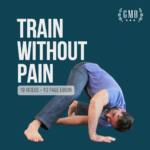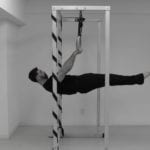We ask a lot from our shoulders–the strength and flexibility to reach, hold, lift, carry, press, and pull. It’s no wonder that the stress and strain of everyday life can cause shoulder pain and even traumatic injuries.
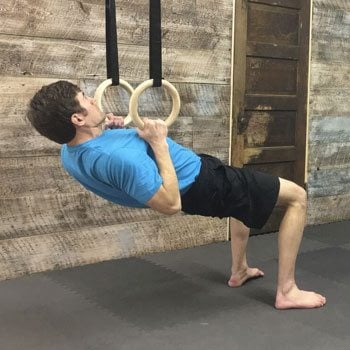 We simply use our upper extremities so much that issues are bound to happen.
We simply use our upper extremities so much that issues are bound to happen.
Shoulder pain is extremely common, with estimates of up to 70% of people affected over the course of their lifetimes. If left untreated, it can turn into a chronic problem that affects daily activities, such as carrying your groceries and reaching to put them away, as well as recreational activities like handstands and other bodyweight control moves we teach here at GMB.
Let’s look at:
- How shoulder pain can get in your way
- What may be causing your shoulder pain
- A daily routine to overcome shoulder pain
Before we get into the meat here, I just want to remind you that the information in this article is no substitute for being seen by a professional in-person if you have ongoing issues–particularly related to pain or weakness. There are certain rare, but serious conditions that can cause shoulder pain, and those conditions must be treated by a physician.
Learn to Train without Pain
Fix the restrictions causing pain in your neck, shoulders, back, hips, knees, and ankles.
👉 More Details
How Shoulder Pain Can Stall Your Progress
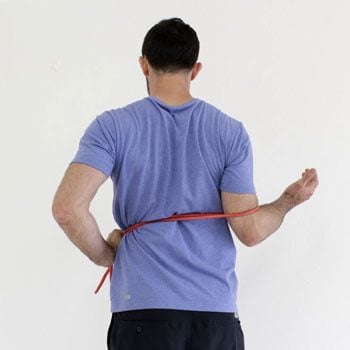 Pain is a very complex subject. One man’s pain is another woman’s discomfort.
Pain is a very complex subject. One man’s pain is another woman’s discomfort.
The latest pain science reveals that there can be little correlation between tissue damage and the perceived pain. You can take two MRI scans of different people showing obvious structural problems, and one will report no pain while the other can barely move without wincing.
Pain is a construct that is emergent, complex, and without simple solutions.
But no matter what may be causing your pain (we’ll get to that in the next section), it can severely stall your progress toward your training goals, not to mention your day-to-day function.
Because the shoulder girdle is so complex–virtually all of our upper body muscles converge with the shoulder in some way–pain in this area can get in the way of a wide array of movements and positions. This can include:
- Overhead movements, like handstands or overhead squats.
- Pressing movements, such as push-ups or dips.
- Pulling movements, such as pull-ups or rows.
Very few training goals can be achieved without involving the shoulder girdle at all, so shoulder pain is definitely going to get in your way if you don’t address it.
What Causes Shoulder Pain?
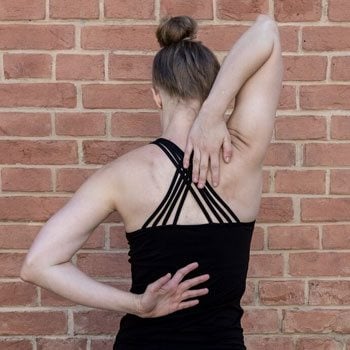 When most people talk about the “shoulder joint,” they are likely referring to the ball and socket joint formed by the humerus (the upper arm) and the scapula (the shoulder blade).
When most people talk about the “shoulder joint,” they are likely referring to the ball and socket joint formed by the humerus (the upper arm) and the scapula (the shoulder blade).
The shoulder is a shallow socket, which allows for a much greater range of motion at various angles than the deeper socket of the hip. However, the shoulder is comprised of a number of other, smaller joints which also contribute to shoulder movement, mobility, and pain.
This complex network of joints means that the causes and solutions to shoulder pain and problems are not simple, but generally, it boils down to poorly coordinated movement at the shoulder.
The causes of injuries can range from the obvious (trauma from a fall) to the more intricate (nerve irritation decreasing muscle strength, leading to improper joint positioning). Whether it is specific muscle weakness, or flexibility problems (both too much and too little) at muscles, ligaments, and within the joint itself, these all lead to impaired movement patterns.
With all that said, the two most common causes of shoulder pain are:
- Impingement–There are a variety of causes for impingement syndromes, from muscle strength and flexibility imbalances, capsular tightness, neurological effects, and so on, but the global end result is the irritation of tendons, bursa, and other tissue causing inflammation and pain. Impingement is generally a sharper pain that quickly subsides when you are out of that range of motion.
- Tendonitis–This is literally inflammation of the tendon. If symptoms don’t subside with rest (~2 weeks), this indicates that a continued stress on the tissue is causing the inflammatory response. Tendonitis tends to ache and usually lingers for longer than impingement.
Impingement and tendonitis go hand-in-hand, however, and there can be many possible underlying causes for both conditions. It’s important to address problems early so that chronic conditions do not occur.
Shoulder Pain Routine
Once you’ve been checked out by a professional, and cleared for movement, the following routine will be helpful in addressing the most common causes of shoulder pain.
These exercises involve a combination of strength, flexibility, and motor control through a wide variety of motions.
👉 Download this routine as part of Train Without Pain.
This routine can be practiced daily until you start feeling some relief, but it’s important to pay attention to how the exercises feel, and avoid or modify movements that exacerbate your pain.
Let’s look at each exercise in detail.
L-Stretch
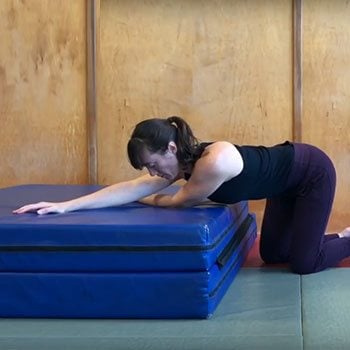
- On your knees in front of a bench or other elevated surface, pull one arm across your chest and lean forward so that your chest is resting on your arm.
- Extend the other arm in front of you.
- Lean towards the shoulder of the arm that’s pulled across your chest. The movement may be very slight, or you may have more movement–it just depends on where your mobility is at. You should feel a stretch at the back of the shoulder capsule.
- Move in and out of the stretch 10 times, then hold for 15-30 seconds. Repeat on the opposite side.
Shoulder Flexion and Upper Thoracic Extension
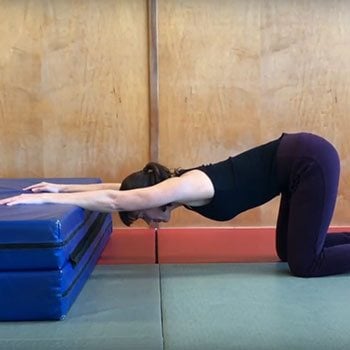
- Extend your arms straight on a bench or elevated surface. You can stay up on your knees like Rose demonstrates, or you can drop into more of a kneeling position–whatever is most comfortable for you.
- Press into the bench as you bring your chest down towards the ground and forward towards the bench, in one sweeping motion. Focus on rolling the shoulders outward as you move in and out of the stretch.
- This motion puts the shoulders into a flexed position, while extending the thoracic spine, which has a tendency to get very tight on many people.
- Move in and out of the stretch 10 times, then hold for 15-30 seconds. You can also move from side to side while you are in the stretched position, as Rose demonstrates.
- Once you do both arms, you can work on one arm at a time.
Bent Arm Scaption Plane Stretch
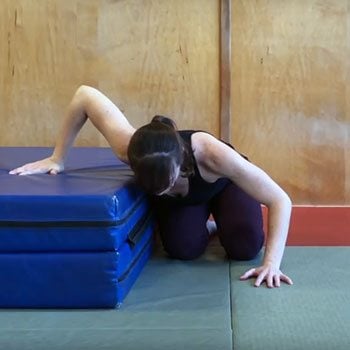
- Kneel next to an elevated surface, and place one palm down on the surface, with your elbow pointed up.
- Rotate the shoulder capsule in and out, as Rose demonstrates. You should feel a good stretch in your pec at the stretched position.
- Move in and out of the stretch 10 times, then hold for 15-30 seconds. Repeat on the opposite side.
Bent Arm Thoracic Extension
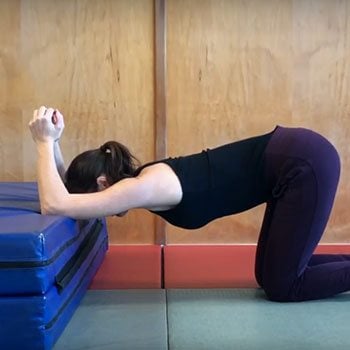
- For this stretch, you will have your arms bent, with your elbows resting on the bench in front of you.
- The motion will be the same as the previous stretch, but this time, you will press the elbows into the bench to encourage a deeper stretch in the thoracic spine.
- Move in and out of the stretch 10 times, then hold for 15-30 seconds.
Prone Scapular Series
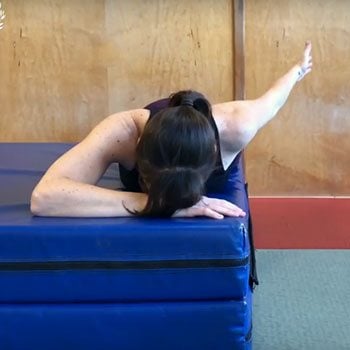
- Lie down on an elevated surface (a bench or even a bed works), with one arm hanging off of the surface.
- Depress the shoulder of the hanging arm, then rotate the arm backwards, and hold it in the stretched position for a few seconds, then bring it back to resting. Repeat 10 times.
- Then, bring the arm forward, rotating the shoulder outward as you do so. Hold it in the forward position for a few seconds, then bring it back to resting. Repeat 10 times.
- Repeat both motions on the opposite shoulder.
Prone Shoulder Circumduction

- Next, you will put the pieces together. Bring the arm forward, then extend it outward, then behind you, then bring it forward to rest, creating a half circle.
- Go in one direction 5-10 times, then reverse directions.
- Be sure to repeat on the other side.
Scapular Weightbearing
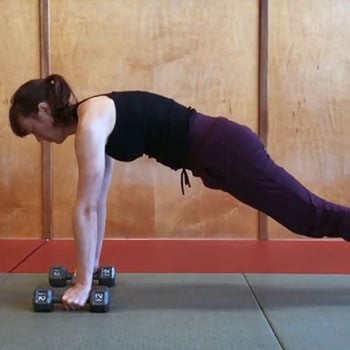
- Here, you will add some weightbearing to your shoulders, by raising your hands up on parallettes or dumbbells (whatever you have around), while in a plank position.
- Keep the elbows straight as you create circles with your shoulders.
- Do 5-10 circles in one direction, then go in the opposite direction.
Motor Control Play Overhead
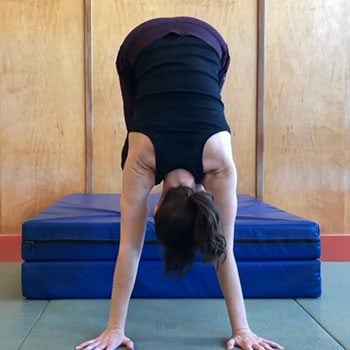
- For this exercise, you’ll want to place your hands on the ground, with your feet on an elevated surface. As much as possible, try to press into the ground to open up the shoulders. If having your feet elevated is uncomfortable, you can do these exercises from a standard downward dog position.
- The purpose of this exercise is to train motor control, so what that means is you should play around with different ways to move the shoulders while in this position. There is no set pattern of movements–just see how different movements and angles feel for you.
Motor Control Play on Parallettes
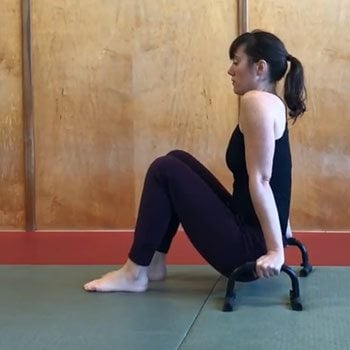
- Here, you will use dumbbells or parallettes to support your hands. Press down into those supports, while keeping the chest up and the elbows straight.
- Following the same idea as the previous exercise, the idea here is to play around with moving your shoulders in different directions while supported in this way. Try shrugging your shoulders, doing circles, moving from side to side–whatever feels good to you.
How to Use This Routine to Overcome Shoulder Pain
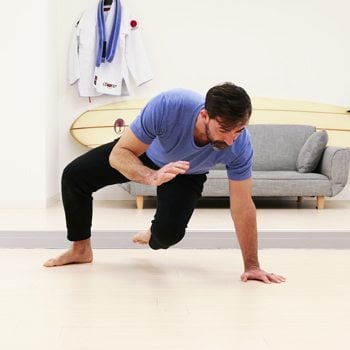 If you are training for a sport or have physical goals in your exercise regimen, you are probably already aware of what you need to do to improve your performance. Goals give you direction and a sense of purpose, when you otherwise may feel like you are just floating along.
If you are training for a sport or have physical goals in your exercise regimen, you are probably already aware of what you need to do to improve your performance. Goals give you direction and a sense of purpose, when you otherwise may feel like you are just floating along.
But it’s also important to bring novel movements into your routine, like we demonstrated in some of the exercises above.
Novel movements break up your normal routine and wake up your mind and body. Physical habits and holding patterns creep up on you slowly and settle in without you being aware. And that can be detrimental, especially when it concerns chronic shoulder pain.
There can indeed be a habit of pain–you can be so accustomed to shoulder pain and dysfunction that it gets “sticky.”
We tend move in the same ways day after day especially in our exercise training. Being stuck in these same movement patterns is a big player in continuing pain complaints, despite different treatments.
Your Shoulders Work Best When They Are Supported By The Rest Of Your Body
You’ve likely noticed that shoulder aches rarely start there. Usually, they’re compensating for issues like a tight thoracic spine, weak core control, or stiff wrists. That’s one reason many of our clients have reported decreases shoulder pain from working through our Elements program–the exercises engage the shoulders in specific ways, while incorporating novel movements that are quite a bit different from what most people are used to.
Integrate Your Whole Body and Feel Better Everywhere
Shoulder-specific exercises can help at first, but integrating your shoulders into full-body movement is key. Elements takes the principles of shoulder stability and applies them in a whole-body context.
There’s also a Gradual Track in Elements provides a gentler introduction, which ideal for sensitive shoulders needing reduced time on the hands and shorter sessions.

